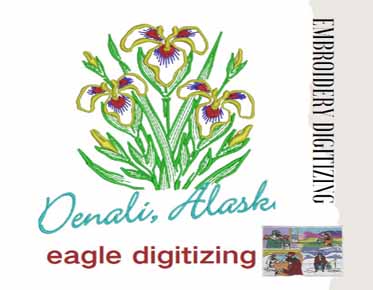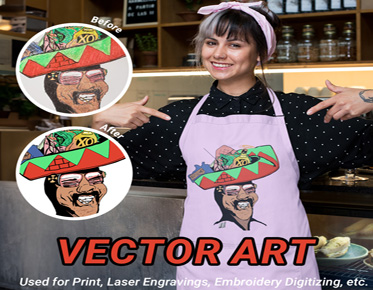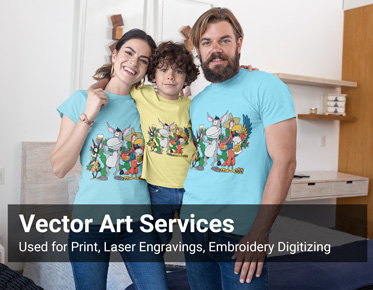What can be done to transform gifts with high-quality embroidery and vector art?
Welcome to the World of Custom Gifts!
In today's vibrant marketplace, custom gifts have emerged as a cherished way to celebrate special moments and express personal creativity. Whether for birthdays, weddings, or corporate events, these bespoke items offer a unique touch that standard gifts often lack.
Importance of High-Quality Embroidery Digitizing and Vector Art
At the heart of creating exceptional custom gifts lie two crucial elements: embroidery digitizing and vector art design. These processes are not merely technical steps but essential techniques that elevate the quality and appeal of personalized items. Let's look at each feature to see what it means and how it helps to create memorable gifts.
Advantages of Vector Art for Custom Gifts
Scalability Without Loss of Quality
One of the key benefits of vector art is its scalability. Whether the design needs to fit on a small keychain or a large banner, vector graphics maintain their sharpness and detail at any size. This flexibility is invaluable in custom gift production, where designs often need to be adjusted for various product dimensions.
Compatibility with Various Printing Methods
Vector art's versatility extends to its compatibility with different printing techniques. Whether it's screen printing, laser engraving, or vinyl cutting, vector files ensure that the design transfers smoothly onto the chosen medium without loss of quality or fidelity.
Choosing the Right Design for Your Custom Gift
Assessing Design Complexity
When selecting a design for a custom gift, it's crucial to consider its complexity. Intricate designs may look stunning but can pose challenges during digitizing or printing, especially on textured or delicate fabrics.
Considering Fabric and Material
The type of fabric or material used for the custom gift influences design choices. Smooth fabrics like cotton allow for finer details, while textured materials may require adjustments in digitizing to ensure the clarity and durability of the embroidery.
Tailoring Design to Recipient's Preferences
Personalization is key in custom gifts. Tailoring the design to reflect the recipient's preferences, whether through color choices, motifs, or personal motifs, enhances the emotional value of the gift and ensures it resonates with its intended recipient.
Process of Embroidery Digitizing
Step-by-Step Overview
Design Submission
The digitizing process begins with receiving the design artwork from the client. This can be in various formats, such as JPEG, PNG, or AI files, depending on the complexity and original source of the design.
Digitizing Process
Skilled digitizers use specialized software to translate the design into stitches. They analyze factors like stitch types, density, and underlay to ensure the embroidery machine accurately reproduces the original artwork.
Quality Control
Before production begins, a thorough quality control check ensures that the digitized design meets the client's expectations. Adjustments may be made to optimize the design for the chosen fabric and embroidery technique.
Tools and Software for Embroidery Digitizing
Popular Digitizing Software Options
Software like Wilcom EmbroideryStudio, Hatch Embroidery, and Brother PE-Design are industry favorites, offering robust tools for both beginners and experienced digitizers.
Features to Look for in Digitizing Software
Key features include stitch editing capabilities, automatic digitizing functions, and compatibility with various embroidery machine formats. Advanced features like 3D rendering and virtual stitching simulations are becoming increasingly popular for previewing final results.
Using Free vs. Paid Software: Pros and Cons
While free digitizing software can be budget-friendly for hobbyists, paid software often offers more extensive support, updates, and advanced features necessary for professional-grade results. Choosing the right software depends on the scale and complexity of your embroidery projects.
Techniques for Achieving High-Quality Embroidery
Importance of Proper Stitch Density
Stitch density refers to the number of stitches per square inch in an embroidery design. Proper density ensures that the design is neither too sparse nor too dense, maintaining fabric integrity and design clarity.
Choosing Suitable Thread and Needles
The type and quality of thread and needles significantly impact the final embroidery. Factors such as thread weight, color fastness, and needle size are chosen based on fabric type, design complexity, and desired finish.
Techniques for Fine Detailing
Achieving intricate details in embroidery requires techniques such as underlay stitching, where a base layer of stitches provides stability and prevents fabric distortion. Satin stitching and fill patterns are also used to enhance texture and visual appeal.
Vector Art Design Essentials
Tools and Software for Vector Art Creation
Adobe Illustrator and CorelDRAW are industry-leading software for creating vector graphics. Their intuitive interfaces and powerful tools enable designers to manipulate shapes, colors, and typography with precision.
Understanding Bezier Curves and Anchor Points
Bezier curves and anchor points are fundamental to vector art design. They allow designers to create smooth, curved lines and define shapes precisely. Mastery of these tools is crucial for achieving clean, professional-looking designs.
Tips for Achieving Clean and Versatile Designs
Maintaining consistent line weights, using layers effectively, and organizing elements logically are essential for clean vector designs. Versatility in design ensures that the artwork can be adapted for different applications and sizes without losing its visual impact.
Optimizing Vector Art for Different Custom Gifts
Scaling Designs for Various Products
Vector graphics excel in scalability, making it easy to resize designs for different custom gifts without compromising quality. Whether it's a small badge or a large wall mural, the design remains sharp and detailed.
Adapting Designs for Different Printing Methods
Understanding the printing method is crucial for optimizing vector art. Adjustments may be needed for color separations, halftones, or engraving techniques to ensure the design translates accurately onto the chosen medium.
Ensuring Compatibility Across Platforms and Formats
Vector files, such as EPS or SVG, are widely compatible across design software and platforms. This compatibility ensures seamless collaboration between designers, printers, and clients, reducing errors and enhancing workflow efficiency.
Common Mistakes in Embroidery Digitizing and Vector Art
Thread Tension Issues in Embroidery
Improper thread tension can result in loose or puckered stitches, affecting the overall quality and durability of the embroidery. Calibrating tension settings according to fabric type and design complexity is crucial for achieving consistent results.
Overcomplicating Vector Art Designs
Excessive detail or unnecessary elements in vector art can clutter the design and make it challenging to reproduce accurately in various sizes or mediums. Simplifying complex designs while retaining their essence is key to effective vector art creation.
Poor File Preparation
Neglecting to prepare files correctly for embroidery or printing can lead to errors in stitching or loss of image quality. Designers should ensure that files are formatted properly, with clear instructions for color, size, and placement.
Quality Assurance and Testing
Importance of Test Stitching
Before full production, test stitching allows digitizers to evaluate how the design performs on the chosen fabric. This process identifies any adjustments needed to optimize stitch density, thread colors, and overall appearance.
Proofing Vector Art Designs
Similarly, proofing vector art involves reviewing mock-ups or samples to confirm that colors, proportions, and details are accurate before final production. Client feedback during this stage is crucial for making necessary revisions.
Revisions and Iterations
Iterative refinement based on test results and client feedback ensures that the final product meets expectations. Effective communication between designers, digitizers, and clients fosters a collaborative process that enhances overall quality.
Cost Considerations in Custom Gift Design
Factors Influencing Cost
Design complexity, material quality, and production volume all influence the cost of custom gifts. Intricate designs or high-quality materials may increase production expenses, while larger quantities often benefit from economies of scale.
Budgeting for Quality Design Work
Allocating a sufficient budget for professional digitizing and vector art ensures superior results and customer satisfaction. Cutting corners on design quality can compromise the final product's appeal and durability, impacting its perceived value.
Balancing Cost and Quality
Finding a balance between cost-effective solutions and maintaining high standards is crucial in custom gift design. Transparent pricing and clear communication about design limitations help manage client expectations while delivering exceptional results.
Marketing Your Custom Gifts
Showcasing High-Quality Embroidery
Highlighting the precision and craftsmanship of embroidery enhances the perceived value of custom gifts. Visual demonstrations through photos or videos of intricate stitching and vibrant colors attract potential customers seeking unique and well-crafted gifts.
Highlighting Vector Art Design Expertise
Emphasizing the versatility and clarity of vector art designs underscores their role in creating customizable gifts that stand out. Case studies or examples showcasing vector art's adaptability across different products can inspire customer confidence.
Leveraging Social Media and Online Platforms
Engaging with target audiences through social media platforms and online marketplaces expands the reach and visibility of custom gifts. Sharing behind-the-scenes content, customer testimonials, and interactive design processes fosters community engagement and brand loyalty.
Future Trends in Custom Gift Design
Technological Advances in Digitizing Software
Continuous advancements in digitizing software are expected to streamline workflows, enhance automation capabilities, and improve accuracy in complex designs. Integration with AI and machine learning may revolutionize pattern recognition and customization options.
Sustainable Practices in Custom Gift Manufacturing
Growing consumer awareness of environmental impact is driving demand for sustainable custom gift options. Eco-friendly materials, reducing waste in production, and ethical sourcing practices are becoming key considerations in design and manufacturing.
Personalization and Customization Trends
The trend towards personalized gifts continues to grow, fueled by consumer desire for unique and meaningful experiences. Technologies that facilitate easy customization, such as interactive design tools and quick turnaround times, are likely to shape future market expectations.
Embroidery digitizing and vector art design are pivotal in creating high-quality custom gifts that resonate with recipients on a personal level. From enhancing design clarity to ensuring scalability and versatility, these techniques elevate the craftsmanship and appeal of bespoke items.
Investing in professional digitizing and vector art services pays dividends in the form of superior design quality, customer satisfaction, and brand differentiation. By understanding the nuances of these processes and embracing future trends, businesses can innovate and thrive in the competitive landscape of custom gift design.



